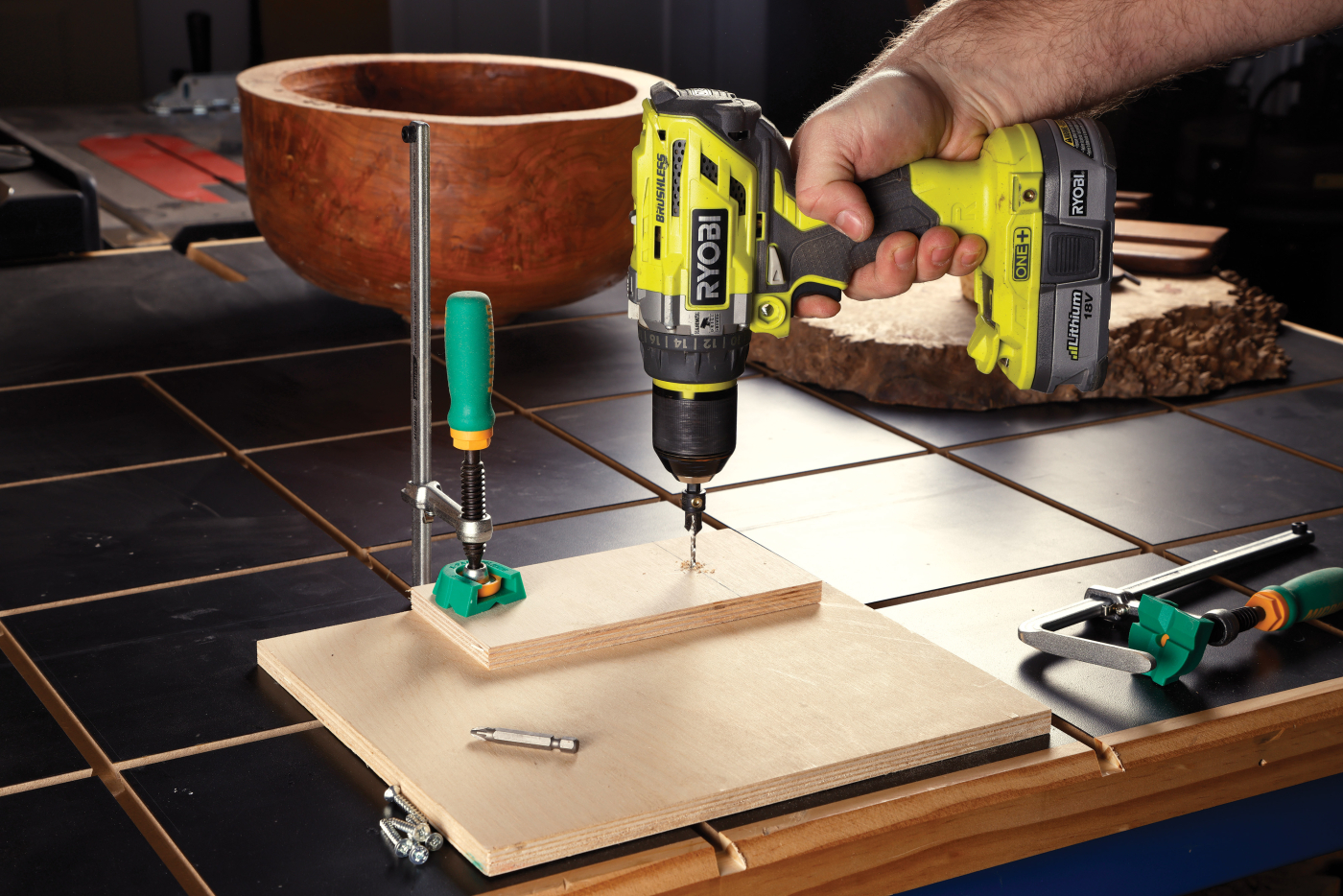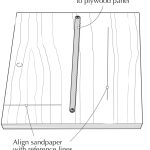We may receive a commission when you use our affiliate links. However, this does not impact our recommendations.

Demystifying volts, amp hours, and types of cordless tool motors.
More and more, cordless tools are becoming everyday fixtures in the woodworking shop. The most common of these is the drill, which you can see broken down below. Most cordless power tools have the same basic components, though, so once you understand how one tool works, you’ll be well on your way to understanding them all.
 Volts vs Amp-Hours
Volts vs Amp-Hours
The two numbers that appear on the sides of most tool batteries are volts (V) and amp-hours (Ah). So what’s the difference? If we were to use a car as an analogy, volts would be how much horsepower/torque your engine has, while amp-hours would be the size of the gas tank. (Before any battery engineers write us letters explaining how inaccurate that is, remember we’re a woodworking magazine, not a scientific publication.)
When comparing the different levels of voltage, it’s important to remember that this reflects the peak available power, not the amount of power a tool is constantly using. That’s why you don’t see any normal drills with 40V batteries—all that power just adds unnecessary weight to the tool. It’s also the reason a 12V drill can complete 90% of the tasks of an 18V one. So, when looking at the difference in voltage between tools, higher isn’t always better.
Amp-hours is a term that is a bit more misunderstood in the world of batteries and battery health. Most people only look at the voltage a battery provides and completely ignore the other number next to it. However, the length of time a tool will run is often just as important as how much power it has. A 1.5Ah 20V battery is going to run out of juice much faster than a 3Ah 12V battery under normal usage. Not only does this interrupt your work, but it can also shorten the life of a battery (see Battery Life Tips, near bottom). Amp-hours is especially important with tools that are constantly running, like a sander.
Types of Batteries
Historically, there have been two main families of batteries in power tools; nickel-based and lithium-based.
Nickel batteries all have nickel oxide hydroxide for the positive electrode and could be paired with cadmium (nickel-cadmium shorted to NiCad) or hydrogen (nickel-metal hydride or NiMH) on the negative electrode. Both NiCad and NiMH batteries have a fairly low power density and are susceptible to developing a “memory” if not discharged fully before each recharge. Up until only a few years ago, you could find tools with nickel-based batteries in discount or base tools lines, though they are all extinct at this point.
Lithium batteries feature a lithium compound for the positive electrode and graphite for the negative. Though the lithium compound may vary, they all share the same nomenclature of lithium-ion (Li-ion). Li-ion batteries have a very high energy density and have the ability to be recharged many times with minimal performance impact.

Cylindrical batteries are arranged inside of a plastic case. The number and type of cylinders determines the volts and amp-hours.
A very recent change has been occurring with the actual power structure of the batteries themselves. Traditionally, tool batteries, regardless of chemical makeup, are composed of individual power cells to determine voltage and amp-hours. These cells look a bit like a AA battery and are usually stacked horizontally within the battery pack.

This new technology features flat battery packs that are more space efficient. This allows more amp-hours in a smaller, lighter package.
However, DeWalt recently launched a new type of battery pack that uses flat cells stacked on top of each other. These cells, a bit more like the battery packs found in cell phones, are more space-efficient, which allows for greater Ah in a smaller package. FLEX, a German power tool company, has also announced the upcoming release of a flat-stack battery pack. It would not be surprising if more tool manufacturers start using this type of pack in the coming years to stay competitive.
What’s the difference between brushed and brushless motors?
The motor inside your tools is another area that has seen changes in recent years as well. Electric motors currently fall into two camps: brushed and brushless.
When a motor is turned on, it activates a magnetic field with the tool. This magnetic field creates rotation between the stationary and moving parts of the tool, causing the rotor to spin. The magnetic field needs to be constantly rotating to power the tool as it’s used.

The contact between the brushes and commutator controls the power delivery for the motor. This sends current to the windings, turning them off and on to generate a rotating magnetic field.
Brushed motors use mechanical timing to manage this rotation; the brushes (often made of graphite) send communication to magnetics within the motor. There are two types of magnets—permanent ones to provide a stationary magnet field and windings, which are actuated on and off to create propulsion. The brushes, which are stationary, send the signal to each winding coil whether it should be off or on. This continued attraction and repulsion is what actually causes the motor to spin. Brushed motors rely on constant contact between the brushes and the commutator, which means that as the brushes wear down with time, the motor will lose power and finally cease to function. You may also notice on older tools that you can see sparks within the tool as it runs—this is often a sign that brushes are starting to wear down.

The electronic commutator works in tandem with hall sensors to monitor the location of the windings and direct current accordingly to manage power delivery for the tool.
Brushless motors also use permanent magnets and windings to create propulsion but utilize electric controllers and sensors to manage the magnetic field. This means that there are fewer moving parts and no brushes to wear down. The electronic controllers also opened up new design opportunities to improve the overall performance of the motor. That means that not only do brushless motors last longer, but they’re also more powerful, efficient, and quieter than brushed motors. Plus, brushless tools tend to be much smaller than previous generations.
So why doesn’t every tool come with brushless motors? Right now, it’s still a matter of cost. Most users don’t need all of the bonuses of brushless motors and can get similar brushed tools for much cheaper. Costs have been falling, though, so don’t be surprised if brushed motors go the way of nickel batteries by the end of the decade.
Tool Maintenance
You’ve probably noticed a theme as you’ve gone through this article—today’s tools are more efficient and long-lasting than the tools of yesteryear. That doesn’t mean you need to throw out your old tools or ignore all maintenance on new ones.
Keep or Not to Keep?
If your shop is filled with NiCad tools with brushed motors, fret not. Many high-quality brushed tools allow for easy brush replacement at regular intervals. Even if it doesn’t, brushed motors can last a very long time under normal use.
Batteries are a bit more tricky—even the most carefully cared-for battery has a finite lifespan. It’s technically possible to replace the cells in a NiCad or NiMH battery, but it’s a task best left to professionals. A better option for most people is upgrading to Li-ion batteries for your old tools.
Some manufacturers make this easier than others—all 18V Ryobi tools can use any 18V Ryobi battery pack regardless of chemical composition. There are also adapters available to use that allow you to use newer batteries in old tools. DeWalt sells an official one that allows you to use their 20V Li-ion batteries in old 18V DeWalt Tools, but for other manufacturers, you’ll need to look at third-party options. Take your time and do your research—the quality and tech can vary wildly, and if used incorrectly, you can damage your tools or batteries.
Heat is the Enemy!
The biggest enemy for all power tools is heat. The more power a motor must generate, the more heat it’s also going to create. Electric motors rely on the rotation of the motor to move air through the tool and keep it cool. If the motor isn’t moving fast enough, there won’t be enough airflow, and heat will start to build up. Eventually, it will critically overheat and cause permanent damage. So how can you prevent that?
The obvious answer is to pay attention to your tools while using them—if the tool is struggling to complete the task, take frequent breaks or reassess your tool choice. Another way to make life easy on your tools is to make sure the blades and bits are sharp, clean, and the right kind for the job. A crosscut blade in your table saw is going to have a harder time ripping a long board than a dedicated ripping or combination blade (not to mention that it’s more dangerous).
Regular Cleaning
This is another easy way to help extend tool life. It can be as simple as wiping off the sawdust when you’re done using a tool for the day. Occasionally, it’s a good idea to check and clean the vents on a tool (since heat is the enemy, of course). A toothbrush can remove gummed-up sawdust, and blowing compressed air into the vents while the tool is running will clear out internal debris. Saw blades and drill bits can be cleaned with a dedicated cleaner or an industrial degreaser. Removing the buildup on a blade can make it as good as new.
Most modern power tools don’t need any lubrication. Any internal lubrication from the factory is specially formulated to last the life of the tool without breaking down. Occasionally chucks might require some lubrication if they start to stick. Don’t just use anything off the shelf, though—consult your owner’s manual or contact the manufacturer so you don’t permanently damage the tool.
Bonus: Battery Life Tips
Heat Management When it comes to batteries, heat is also the enemy. I often hear woodworkers talk about avoiding the cold, but batteries tend to be fine in below-freezing temps. In fact, they’ll generally have no issues all the way down to -4° Fahrenheit. Heat is the real battery-killer, especially in the summer. Temperatures over 175° can cause permanent damage to the battery. That might seem high, but factors like being inside a hot trunk or sitting directly in the sun can cross that threshold easily. Keeping the battery cool will also extend run time and make the charging process more efficient.
Charge Management Pick a charger or charging mode that is applicable to your usage and run time needs. For example, if you’ll be using the tool again soon, charge it all the way. If it’s going to be a while until it’s used again, 50% is the target you should shot for, then fully charge it right before use.
Use Case Pick the proper battery for the application and power tool you’re using. Don’t choose a lower power battery like a 2.0Ah or 4.0Ah for a high-use tool, as this will require frequent charging and decrease the life span of a battery.
What should you do with a dead battery or Tool?
Even with their longer lifespans, modern tools and batteries will eventually wear out. Proper disposal techniques will keep toxic materials out of landfills and allow the valuable lithium to be recycled. To find a recycling center in your area, check out www.Call2Recycle.org.
Here are some supplies and tools we find essential in our everyday work around the shop. We may receive a commission from sales referred by our links; however, we have carefully selected these products for their usefulness and quality.






![How To Sharpen A Gouge [Video]](https://www.popularwoodworking.com/wp-content/uploads/bfi_thumb/dummy-transparent-olcy6s63it1p9yp7uhusjas7c8kahafrhg9su7q9i0.png)


Very much needed and useful article. Where did you get the laminated table top? I have the tools to route the dovetail tracks. The object of desire is the lamination. Thanks, Dietmar.
It’s homemade- two layers of mdf glued and screwed together with melamine on top. It’s actually sagging badly though, going to have to make a new one.